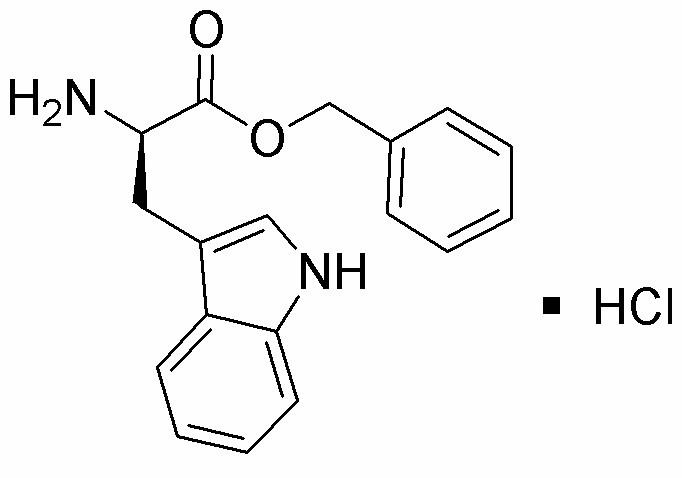D-Tryptophan benzyl ester hydrochloride is widely utilized in research focused on
- Pharmaceutical Development: This compound serves as a precursor in synthesizing various pharmaceuticals, particularly those targeting neurological disorders, enhancing mood and sleep quality.
- Biochemical Research: It is used in studies investigating protein synthesis and enzyme activity, providing insights into metabolic pathways and cellular functions.
- Food Industry: As a flavor enhancer, it can be incorporated into food products to improve taste and aroma, appealing to consumers seeking natural ingredients.
- Cosmetic Formulations: The compound is included in skincare products for its potential to promote skin health and improve hydration, catering to the growing demand for effective cosmetic solutions.
- Neuroscience Studies: It is employed in research examining the effects of tryptophan derivatives on serotonin levels, which is crucial for understanding mood regulation and mental health.
Información general
Propiedades
Seguridad y normativas
Aplicaciones
D-Tryptophan benzyl ester hydrochloride is widely utilized in research focused on
- Pharmaceutical Development: This compound serves as a precursor in synthesizing various pharmaceuticals, particularly those targeting neurological disorders, enhancing mood and sleep quality.
- Biochemical Research: It is used in studies investigating protein synthesis and enzyme activity, providing insights into metabolic pathways and cellular functions.
- Food Industry: As a flavor enhancer, it can be incorporated into food products to improve taste and aroma, appealing to consumers seeking natural ingredients.
- Cosmetic Formulations: The compound is included in skincare products for its potential to promote skin health and improve hydration, catering to the growing demand for effective cosmetic solutions.
- Neuroscience Studies: It is employed in research examining the effects of tryptophan derivatives on serotonin levels, which is crucial for understanding mood regulation and mental health.
Documentos
Hojas de datos de seguridad (HDS)
La SDS proporciona información de seguridad completa sobre la manipulación, el almacenamiento y la eliminación del producto.
Especificación del producto (PS)
La PS proporciona un desglose completo de las propiedades del producto, incluida la composición química, el estado físico, la pureza y los requisitos de almacenamiento. También detalla los rangos de calidad aceptables y las aplicaciones previstas del producto.
Certificados de análisis (COA)
Busque certificados de análisis (COA) ingresando el número de lote del producto. Los números de lote y de partida se pueden encontrar en la etiqueta de un producto después de las palabras "Lote" o "Lote".
Número de catálogo
Número de lote/lote
Certificados de origen (COO)
Este certificado de origen confirma el país en el que se fabricó el producto y también detalla los materiales y componentes utilizados en él y si se deriva de fuentes naturales, sintéticas u otras fuentes específicas. Este certificado puede ser necesario para cumplir con las normativas aduaneras, comerciales y regulatorias.
Número de catálogo
Número de lote/lote
Hojas de datos de seguridad (HDS)
La SDS proporciona información de seguridad completa sobre la manipulación, el almacenamiento y la eliminación del producto.
DownloadEspecificación del producto (PS)
La PS proporciona un desglose completo de las propiedades del producto, incluida la composición química, el estado físico, la pureza y los requisitos de almacenamiento. También detalla los rangos de calidad aceptables y las aplicaciones previstas del producto.
DownloadCertificados de análisis (COA)
Busque certificados de análisis (COA) ingresando el número de lote del producto. Los números de lote y de partida se pueden encontrar en la etiqueta de un producto después de las palabras "Lote" o "Lote".
Número de catálogo
Número de lote/lote
Certificados de origen (COO)
Este certificado de origen confirma el país en el que se fabricó el producto y también detalla los materiales y componentes utilizados en él y si se deriva de fuentes naturales, sintéticas u otras fuentes específicas. Este certificado puede ser necesario para cumplir con las normativas aduaneras, comerciales y regulatorias.


